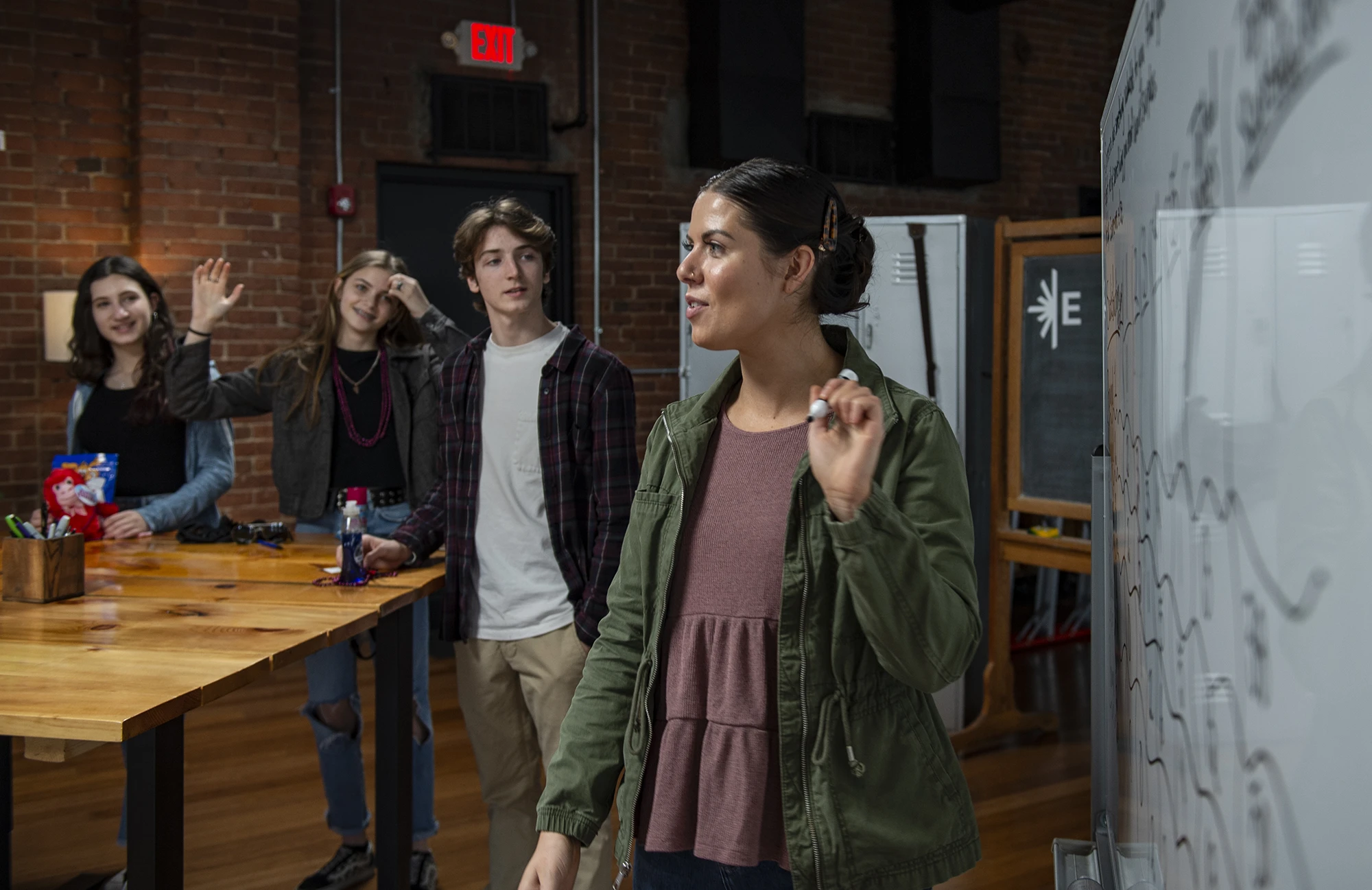
21 Mar The benefits of Project-Based Learning v. Traditional Education
At Votary Films, we often talk about Human Flourishing. It’s a phrase that encompasses a wide range of topics like philosophy, law, politics, health, and religion. One central cornerstone of society that touches all of these is Education.
Being that “school” starts at an early age and continues into early adulthood, it is one of the most influential forces for shaping society.
In fact, the only thing further upstream than education is the family unit, but I’ll save that topic for another post.
Most of the people I speak with agree that the “one size fits all” approach of traditional schooling often fails to cater to the diverse needs and abilities of students. It often stifles creativity and limits the potential of those who do not fit the mold of standardized expectations. Furthermore, traditional schooling tends to prioritize rote memorization over critical thinking, collaboration, and problem-solving skills, which are crucial for success in the modern world.
This was certainly my experience during my one year of traditional schooling.
I went to a private catholic school for 5th grade (although we were not catholic) and I hated almost every second of it. School had the rare qualities of being both boring and stressful.
Why was it boring? Mostly because I couldn’t imagine why I needed to memorize all these facts; I would never use them.
Why was it stressful? There were many reasons, but here are a few:
- I memorized things much slower than everyone else, so I couldn’t keep up
- It was intensely difficult to pay attention while sitting for hours
- Kids are ruthless at that age
- Most of the teachers operated with impatient top-down authority, and I don’t blame them
So, after one of the worst years of my life, with terrible grades in hand, I was able to tearfully convince my mother to let me be homeschooled again.
I am glad that I completed that year, but I am also very glad I was able to have a personalized learning structure for almost my entire young academic life.
My mom’s style was to do short sprints of “teaching” (mostly asking me questions), in between my hands-on projects, which I could choose like woodworking, writing, and experimenting with my dad’s electronic parts. These projects – which I quickly became invested in – gave me an emotional connection with “the facts”. After all, if my math didn’t add up in carpentry, it might just end in me tossing the piece in frustration.
My most powerful memories of deep learning are micro versions of the hero’s journey. With a glimpse of what was possible in my mind’s eye I would answer the call to adventure, get to work, and of course things would get difficult. I would try to quit, but my “guide” encouraged me, asked questions, and nudged me on (sometimes with reward offerings). Eventually I’d experience a breakthrough after enough trial and error, and then I would realize I have grown enough knowledge and muscle to do it again… this time going deeper, bigger, and more impressive.
Telling the story of what I experienced was also powerful for programming emotional intelligence, increasing self motivation (the better type of work ethic), and sparking new creativity.
Project-Based Learning & Storytelling: A Powerful Combination
Humans are natural storytellers, and stories have always played a vital role in our learning process. They help us make sense of everything, foster empathy, and ignite our imagination. Treating a project like a story we’re writing and then telling isn’t just a good idea for “education”, it is the education. We really don’t learn something well until we can teach it.
It’s worth mentioning that the traditional schooling system, as we know it, was developed during the Industrial Revolution to meet the demands of a growing industrialized society. The primary goal was to produce a workforce with basic skills and knowledge, capable of performing repetitive tasks in factories and offices. This led to the creation of a standardized education system, with a rigid curriculum, fixed schedules, and uniform teaching methods. While this approach may have served its purpose at the time, it has become increasingly clear that it fails to meet the diverse needs of today’s learners.
Our world is changing blisteringly fast, especially with technology.
Ultimately school is supposed to equip students with the skills, knowledge, and adaptability necessary to thrive in an unpredictable future. Learning facts should not be the goal but rather fostering resourcefulness, creativity, critical thinking, and problem solving. These habits can often be built very quickly and effectively when the student has natural energy from their own sense of agency and personal incentives.
Project based learning offers a promising solution to this challenge and it can be supercharged with the two-punch combo of “writing your story” and then “telling your story.”
What do I mean?
When someone writes a story, they are doing so with intention. For example, willfully taking on a personal project aimed at achieving something is the act of writing a chapter in one’s story.
Telling that story is an act of accountability and growth acceleration.
I go into this topic in much more detail in my book, Fly: Take your Business to New Heights using the 7 Powerful Steps of Story Acceleration.
I plan to unpack this even more by releasing the book chapters as blogs, but for now here is a quick acronym:
B.O.B.O.D.D.Y.
I’m just kidding, the acronym is S.T.O.R.Y.
- See the goal
- Take action
- Overcome obstacles
- Reflect and record what you really learned
- Yell it from the rooftops
Okay, yelling it from the rooftops is a bit heavy-handed, but actually yes it is powerful to tell the stories of what you have truly learned. Many people neglect the phase of telling their stories and consequently they lose powerful opportunities such as:
- The opportunity to have their conclusions challenged by others
- The opportunity to truly learn from teaching
- The opportunity to build natural authority and influence
- The opportunity to to help others in the midst of their stories
A future built for Human Flourishing
Progress + gratitude = happiness.
Some of the least happy and productive people are those whose creativity and motivation has been crushed by systemic top-down dictatorships. When I look around, I see too many people seemingly stuck in a victim mentality, lacking a healthy view of themselves, strong habits in gratitude, self-motivation, critical thinking, and continuous improvement.
There are many more forces at play here, mostly spiritual in nature and, again, I’ll give more of my thoughts on that in later posts.
I want a future society where humans flourish more easily. I want this for my kids and grandkids. A thriving future society requires self-led individuals with creativity, wisdom, and strength of character to lead themselves (and then lead others)… and of course we need institutions that foster this!
Recently, one of our current client partners in education informed me that 15% of people can naturally visualize their potential future with enough clarity to be motivated into action. The other 85% can need a framework to find their way.
What better framework is there than play? Allowing young people to take on fun projects of their choosing (often involving cooperation) where they can discover their natural talents and the relevant facts and principles needed for the project (story); this is advanced play, and it’s critical for the game of life.
Ultimately, every human wants freedom. Freedom to have fun and choose our own path. I believe that we have a responsibility to give our children a better world than we had. My suggestion is we get off the antiquated indoctrination bus that’s been wobbling us along with square wheels and move into the fast lane, embracing incentivized project-based learning supercharged with socratic questioning and student led storytelling.
Are you interested in learning more?
Over the years, we’ve partnered on video projects with numerous educators interested in deviating from the confines of traditional education. Here are just a few examples of those stories:
What do you think? Start a Conversation.
